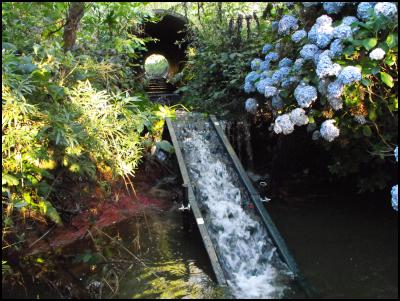Manawatu’s native fish can now swim freely

13 February 2012
Manawatu’s native fish can now swim freely
Native fish within the Manawatu catchment can now swim freely, thanks to the installation of a number of fish ladders and fish ropes.
As part of work for the Manawatu River Accord, Horizons Regional Council has installed 10 fish ladders and two fish ropes throughout the catchment, at sites ranging from around Ekatahuna, through to Woodville and across to Shannon and Foxton. Fish ladders are planned for a further four sites.
These sites have been selected according to the number and conservation status of fish that are likely to benefit, and the amount of habitat that will be made available to them upstream.
The fish ladders, made of fiberglass, may benefit a number of native species including Inanga, Giant kokopu, Banded kokopu, Koaro, Shortjaw kokopu, Torrent fish , Shortfin and Longfin eel and a number of Bully species.
Furthermore, fish such as Banded kokopu and Koaro are also very good climbers and it has been discovered they are able to clamber up mussel rope (used in mussel farming). To aid their movement, Horizons has used ropes in the Kahuterawa as there are a lot of Kokopu in that catchment.
“Many native New Zealand fish spend part of their life cycle at sea and migrate into and out of freshwater. Obstructions such as perched culverts, weirs and dams can stop them swimming upstream, restricting the amount of habitat available to them,” says Horizons environmental scientist, Carol Nicholson.
“By building fish ladders in the Manawatu catchment we hope to increase the distribution and abundance of native fish in the area”.
No fish ladders will be installed at sites which could allow trout access to upstream areas, where they would place native fish populations at risk.
ENDS


 Gordon Campbell: On Aussie Election Aftershocks And Life Lessons
Gordon Campbell: On Aussie Election Aftershocks And Life Lessons NZ Government: PM’s Science Prizes Celebrate Excellence
NZ Government: PM’s Science Prizes Celebrate Excellence Department of Conservation: Pinnacles Hut, Summit Track Set For Improvement
Department of Conservation: Pinnacles Hut, Summit Track Set For Improvement  Tax Justice Aotearoa: New Report Illustrates Tax System Failures
Tax Justice Aotearoa: New Report Illustrates Tax System Failures PSA: PSA Welcomes Increased Defence Spend On Civilian Salaries
PSA: PSA Welcomes Increased Defence Spend On Civilian Salaries New Zealand Government: New Helicopters A Commitment To Global Security
New Zealand Government: New Helicopters A Commitment To Global Security Greenpeace: Greenpeace Calls On Luxon To Show Leadership On Dairy Pollution As Canterbury Floods Highlight Growing Climate Crisis
Greenpeace: Greenpeace Calls On Luxon To Show Leadership On Dairy Pollution As Canterbury Floods Highlight Growing Climate Crisis


